Tomatoes are one of the most widely cultivated vegetables worldwide. From North America to Europe, Asia, and Africa, gardeners rely on smart planting techniques to enhance yields and quality. One of the most effective methods is companion planting. Using tomato companion plants strategically can improve growth, enrich flavor, deter pests, and attract pollinators. This guide explores the ten best companion plants suitable for tomatoes in diverse climates and gardening setups globally.
Understanding which plants thrive alongside tomatoes is key to transforming an ordinary harvest into a plentiful one. These techniques are effective for both urban gardens and large-scale farms worldwide.
This guide will show you the best tomato companion plants to grow for maximum benefits.
If you’re also curious about seasonal gardening, check out our Guide to Vegetables You Can Grow in September
Basil – The Classic Tomato Companion Plant for Tomatoes
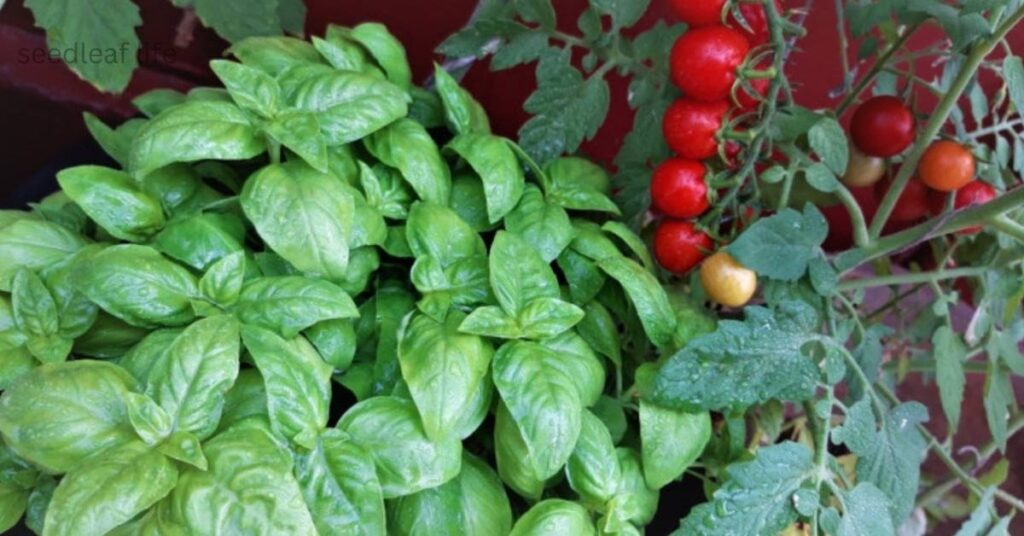
Basil not only makes tomatoes taste better but also helps protect them from harmful pests. Many gardeners believe that planting basil near tomatoes leads to a healthier, more productive harvest. If you love growing herbs that pair beautifully with flowers too, check out our guide on Rose Companion Plants.
Benefits of Basil with Tomatoes
- Enhances Tomato Flavor
Basil is one of the best tomato companion plants, improving the sweetness and richness of ripe tomatoes.
Repels Harmful Pests
Its strong aroma helps keep away aphids, hornworms, and whiteflies, protecting your tomato plants naturally.
Attracts Pollinators
Bees and butterflies are drawn to basil flowers, which boosts tomato pollination and leads to better yields.
Supports Healthy Growth
When planted together, basil creates a healthier environment that helps tomatoes grow stronger and more productive.
Reduces Disease Problems
Basil lowers the chances of fungal infections like blight and mildew that often attack tomato crops.
Adds a Fresh Fragrance
The pleasant scent of basil makes the garden more inviting while also discouraging flies and mosquitoes.
Improves Garden Appearance
Its lush green leaves and small flowers add beauty and charm alongside your tomato plants.
Encourages Organic Gardening
Basil acts as a natural pest control option, reducing the need for harmful pesticides.
Provides Longer Harvests
By reducing stress and protecting against pests, basil helps ensure a steady and extended tomato harvest.
Proven Gardening Tradition
Basil has long been considered one of the best tomato companion plants, trusted by gardeners worldwide.
Carrots – Improve Soil Aeration for Tomatoes
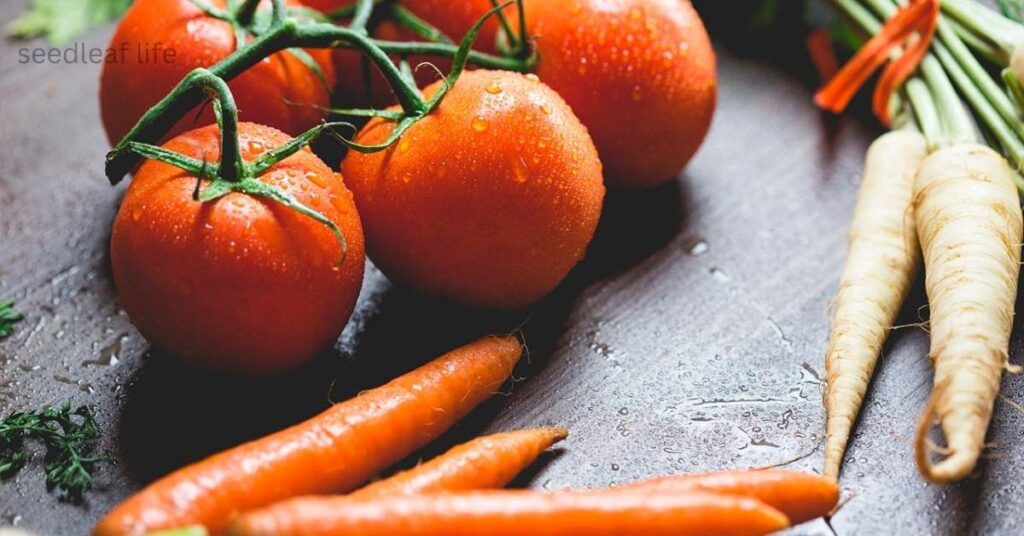
Carrots are an excellent tomato companion plant because their roots naturally loosen the soil. This helps tomato roots get more air, water, and nutrients. When grown together, carrots improve soil structure while tomatoes provide shade, creating a win–win partnership.
Benefits of Carrots with Tomatoes
- Loosen and Aerate the Soil
Carrot roots naturally break up compacted soil, allowing tomato roots to spread more easily.
Improve Water and Nutrient Absorption
By enhancing soil structure, carrots help tomato plants access more moisture and vital nutrients.
Grow Well in Partial Shade
Carrots thrive under the shade of tall tomato plants, making them ideal garden partners.
Avoid Nutrient Competition
Carrots don’t heavily compete with tomatoes for nutrients, ensuring both crops grow healthily together.
Maximize Garden Space
Planting carrots with tomatoes allows gardeners to grow two crops in the same bed, saving space.
Support Stronger Tomato Roots
Loosened soil from carrot growth encourages stronger and deeper tomato root systems.
Create a Balanced Microclimate
The canopy of tomato plants protects carrots from excessive sun, while carrots keep soil airy.
Promote Organic Gardening
As natural soil improvers, carrots reduce the need for fertilizers when grown with tomatoes.
Encourage Healthy Harvests
With improved root growth and soil aeration, tomatoes produce healthier and more abundant fruits.
Proven Companion Planting Tradition
Carrots have long been recognized as one of the best tomato companion plants, trusted by home gardeners worldwide.
Onions – Natural Pest Repellent Near Tomatoes
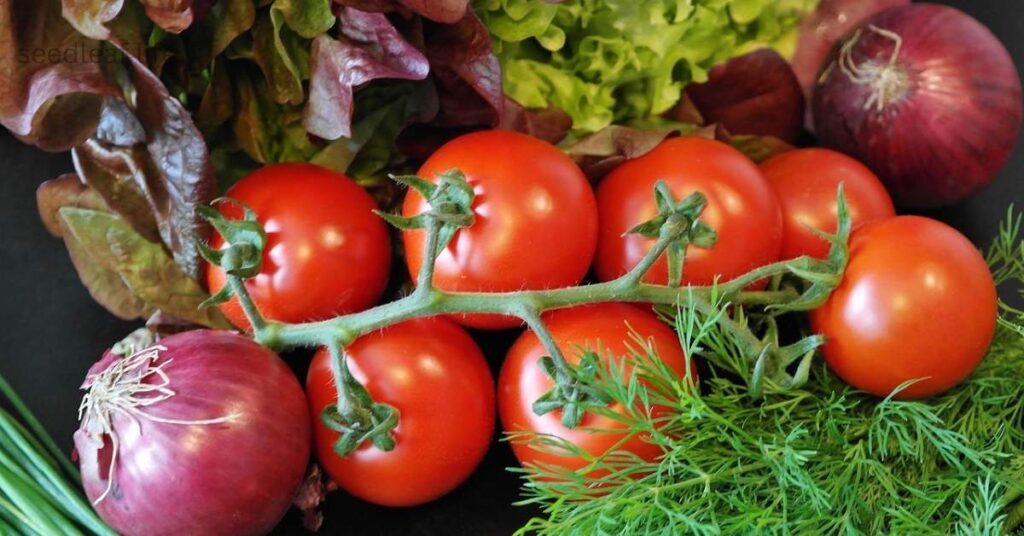
Onions are one of the most reliable tomato companion plants because they naturally repel many common pests. Their strong smell keeps harmful insects away, protecting tomatoes from damage. Growing onions alongside tomatoes is a simple, chemical-free way to keep your garden healthier.
Benefits of Onions with Tomatoes
- Repel Harmful Pests
The strong smell of onions helps deter aphids, slugs, cabbage worms, and other insects that often attack tomato plants. - Protect Tomatoes Naturally
Growing onions nearby reduces the chances of insect infestations without relying on chemical pesticides. - Require Minimal Space
Onions take up very little room in the garden, making them perfect for interplanting with tomatoes. - Improve Overall Garden Health
Their natural pest-repelling properties create a healthier environment for tomatoes and other crops. - Provide an Extra Edible Crop
Along with tomatoes, onions give gardeners a second harvest from the same growing space. - Enhance Companion Plant Diversity
Onions add variety to the garden bed, improving soil balance and reducing the risks of monoculture planting. - Discourage Larger Garden Pests
The pungent smell of onions can also help keep away animals like rabbits and deer that may damage tomatoes. - Encourage Stronger Tomato Growth
With fewer pests attacking them, tomato plants can focus their energy on producing healthy fruits. - Support Organic Gardening
Onions act as a natural line of defense, allowing gardeners to reduce chemical use and grow organically.
Garlic – A Powerful Tomato Companion Plants
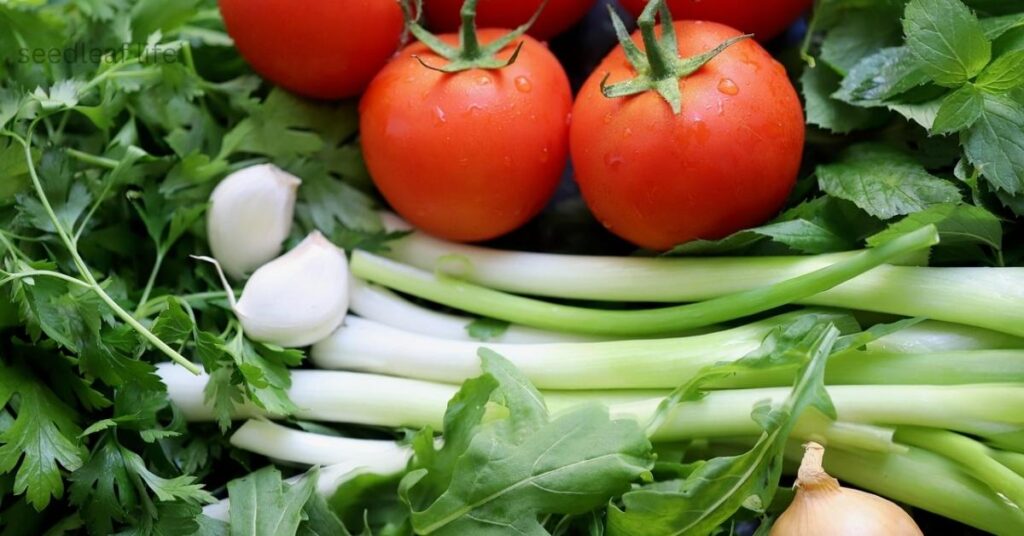
Garlic is a powerful tomato companion plants that helps keep diseases and pests under control. Its natural compounds act like a shield against fungal infections and harmful insects. When planted near tomatoes, garlic improves plant health and creates a stronger, more resilient garden.
Benefits of Garlic with Tomatoes
- Repels Common Pests
Garlic’s strong smell helps deter spider mites, aphids, and other insects that commonly harm tomato plants.
Provides Natural Antifungal Protection
Garlic, as a tomato companion plants, has antifungal properties that help reduce the risk of blight and mildew…
Boosts Plant Immunity
Growing garlic nearby improves the natural resistance of tomato plants, making them stronger and healthier.
Saves Garden Space
Garlic bulbs require little room, making them easy to interplant alongside tomatoes.
Offers an Extra Harvest
While protecting tomatoes, garlic also provides an additional, flavorful crop for the kitchen.
Discourages Soil-Borne Pests
The sulfur compounds in garlic can reduce nematodes and other harmful organisms in the soil.
Promotes Organic Gardening
By working as a natural pest and disease control, garlic reduces the need for chemical sprays.
Creates a Balanced Garden Environment
When planted together, garlic and tomatoes form a mutually beneficial partnership that improves overall garden health.
Enhances Tomato Yields
With fewer pests and diseases, tomatoes can produce more blossoms and a better harvest.
Proven Companion Planting Tradition
Garlic has been trusted for centuries as one of the best tomato companion plants for healthier gardens.
Lettuce – Ground Cover to Retain Soil Moisture

Lettuce is a simple yet effective tomato companion plants. Since it grows low to the ground, it acts as a natural mulch, helping the soil stay cool and moist. Growing lettuce with tomatoes not only saves space but also creates a healthy microclimate for both crops.
Lettuce is not only a great companion for tomatoes but also one of the vegetables you can successfully grow in September. Learn more in our September Vegetables Guide.
Benefits of Lettuce with Tomatoes
- Provides Natural Ground Cover
Lettuce acts like a living mulch, keeping the soil moist and reducing water evaporation around tomato plants.
Keeps Soil Cooler in Summer
Its low, leafy growth shades the soil, helping regulate temperature during hot weather.
Suppresses Weed Growth
By covering bare soil, lettuce prevents weeds from competing with tomato plants for nutrients.
Thrives in Tomato Shade
Lettuce enjoys cooler conditions and grows well under the canopy of taller tomato plants.
Maximizes Space Usage
Planting lettuce with tomatoes allows gardeners to harvest two crops from the same garden bed.
Improves Soil Health
As lettuce roots break down after harvest, they enrich the soil with organic matter.
Encourages Water Efficiency
Moisture-retaining ground cover from lettuce reduces the need for frequent watering.
Creates a Balanced Microclimate
Together, lettuce and tomatoes help each other by stabilizing soil temperature and humidity.
Reduces Stress on Tomatoes
With less weed pressure and cooler soil, tomato plants can focus energy on producing healthy fruits.
Adds Variety to the Garden
Lettuce not only supports tomato growth but also gives gardeners a fresh, quick-to-harvest crop.
Spinach – A Shade-Loving Tomato Companion Plant
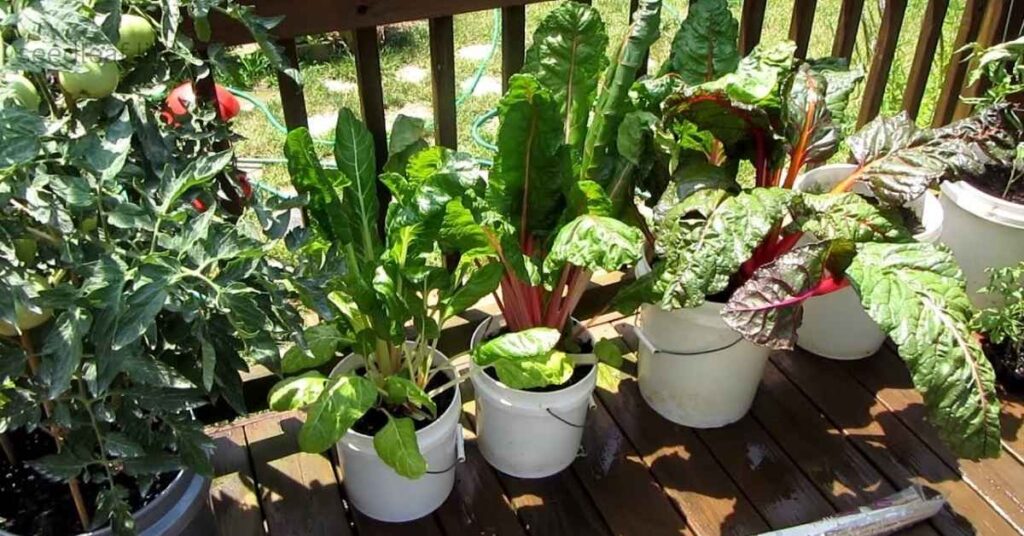
Spinach grows perfectly alongside tomatoes because it enjoys the cool shade provided by taller plants. While tomatoes rise high and capture the sun, spinach thrives underneath, making it a smart use of garden space. This pairing helps both crops grow better without competing for resources.
Benefits of Spinach with Tomatoes
- Thrives in Tomato Shade
Spinach grows well under the canopy of tall tomato plants, staying cool and protected from harsh sunlight.
Makes Smart Use of Space
Tomatoes grow upward while spinach spreads low, allowing gardeners to maximize both vertical and ground space.
Provides Natural Ground Cover
Spinach leaves act like a living mulch, covering the soil and reducing water evaporation.
Prevents Soil Erosion
Its dense growth helps keep the soil in place, especially during heavy rains or watering.
Quick and Easy Harvest
Spinach matures quickly, so it can be harvested without disturbing tomato roots.
Supplies Continuous Greens
Alongside a tomato harvest, spinach provides a steady supply of fresh, nutrient-rich leafy greens.
Improves Soil Microclimate
By covering the ground, spinach keeps soil temperatures stable and creates healthier conditions for tomatoes.
Reduces Weed Competition
Its spreading leaves suppress weed growth, giving tomatoes more access to nutrients.
Encourages Water Efficiency
Shaded soil retains more moisture, reducing the need for frequent watering in the tomato bed.
Adds Diversity to the Garden
Growing spinach with tomatoes promotes crop variety and supports a balanced companion planting system.
Beans – Productive Tomato Companion Plants

Beans are one of the best companions for tomatoes because they naturally enrich the soil. By fixing nitrogen from the air into the soil, beans provide tomatoes with a steady supply of essential nutrients. This partnership helps tomatoes grow stronger, healthier, and more productive.
Benefits of Beans with Tomatoes
- Fix Nitrogen in the Soil
Beans naturally enrich the soil by converting nitrogen from the air into a form that tomatoes can use for healthy growth.
Boost Tomato Growth
With a steady supply of nitrogen, tomato plants develop stronger stems and produce more abundant fruits.
Improve Soil Fertility Naturally
Beans act as living fertilizers, reducing the need for chemical soil amendments in the tomato bed.
Save Garden Space
Many bean varieties grow vertically, making them ideal companions for sprawling tomato plants.
Avoid Nutrient Competition
Beans and tomatoes complement each other well since beans focus on fixing nitrogen rather than competing for soil nutrients.
Support Sustainable Gardening
By enriching the soil, beans help maintain long-term fertility and reduce the gardener’s reliance on synthetic fertilizers.
Provide a Dual Harvest
Growing beans alongside tomatoes gives you not just juicy tomatoes but also protein-rich beans for the kitchen.
Encourage a Balanced Ecosystem
Beans attract beneficial insects that support pollination and overall garden health.
Promote Resilient Tomato Plants
With better nutrition and soil health, tomatoes become less prone to stress and disease.
Proven Companion Planting Practice
Beans have long been valued as reliable tomato companion plants, trusted by gardeners for generations.
Peppers – Compatible Tomato Companion Plants from the Same Family
Peppers and tomatoes belong to the same plant family, making them naturally compatible in the garden. They share similar growing conditions, so both thrive when planted side by side. This pairing allows gardeners to save space while enjoying two delicious harvests.
Benefits of Peppers with Tomatoes
- Share Similar Growing Needs – Peppers and tomatoes both love warm weather and full sun, so they thrive under the same conditions.
- Grow Side by Side Smoothly – Since they have compatible nutrient needs, peppers can be planted with tomatoes without heavy competition.
- Maximize Garden Space – Planting peppers and tomatoes together allows gardeners to grow two productive crops in the same area.
- Improve Garden Diversity – A mix of crops in one bed reduces the risk of pests and diseases spreading too quickly.
- Provide a Dual Harvest – Gardeners enjoy not only juicy tomatoes but also colorful, flavorful peppers from the same space.
- Support Soil Balance – Growing peppers with tomatoes helps maintain a balanced use of nutrients in the soil.
- Encourage Pollinator Activity – Their flowers attract bees and beneficial insects, which improve fruit set for both plants.
- Reduce Garden Stress – Similar watering and care routines make managing peppers and tomatoes together simple and efficient.
Celery – Flavorful and Pest-Repelling Tomato Companion Plants
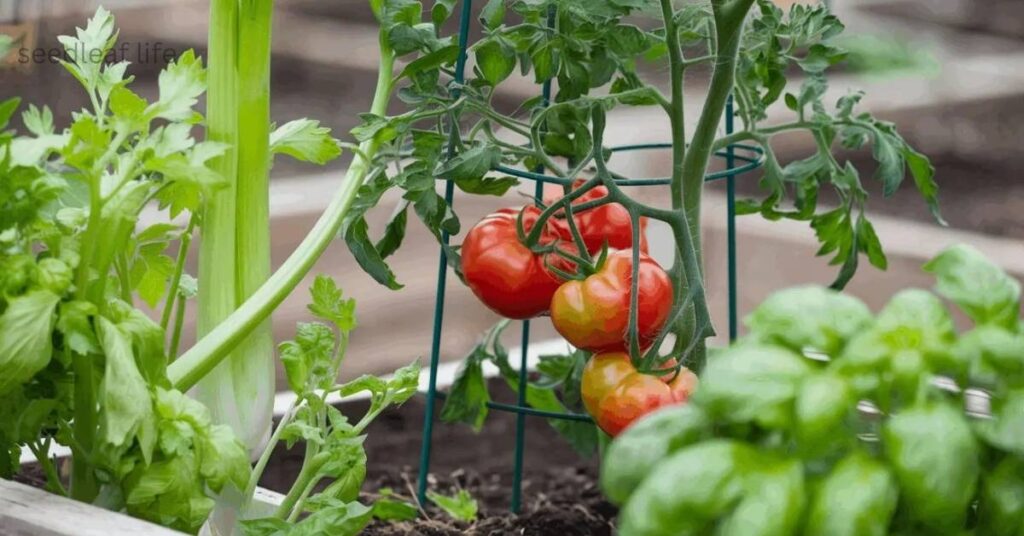
Celery is another excellent tomato companion plants that brings both flavor and protection to the garden. Its strong scent helps keep harmful insects away, while its compact growth makes it easy to plant near tomatoes. This pairing ensures healthier plants and a more productive harvest.
Benefits of Celery with Tomatoes
- Repels Harmful Pests
Celery’s strong scent naturally deters whiteflies, aphids, and other insects that commonly attack tomatoes. - Thrives in Tomato Shade
Its compact growth allows celery to grow well beneath taller tomato plants, making smart use of space. - Avoids Heavy Nutrient Competition
Celery has different nutrient needs, so it doesn’t compete aggressively with tomatoes in the soil. - Adds Garden Diversity
Growing celery alongside tomatoes increases plant variety, creating a balanced and healthier ecosystem. - Provides a Second Harvest
Along with tomatoes, gardeners also enjoy crisp, flavorful celery stalks from the same planting area. - Supports Organic Gardening
With its natural pest-repelling qualities, celery reduces the need for chemical sprays. - Improves Soil Microclimate
Its presence helps maintain soil moisture and balance around tomato roots. - Discourages Larger Pests
The aroma of celery can help mask tomato plants, making them less attractive to animals like rabbits. - Encourages Strong Tomato Growth
With fewer pest pressures, tomato plants can focus more energy on producing healthy, abundant fruits. - Proven Companion Planting Practice
Celery has long been trusted by gardeners as a reliable tomato companion plant for boosting harvest success.
Radishes – Fast-Growing Tomato Companion Plants
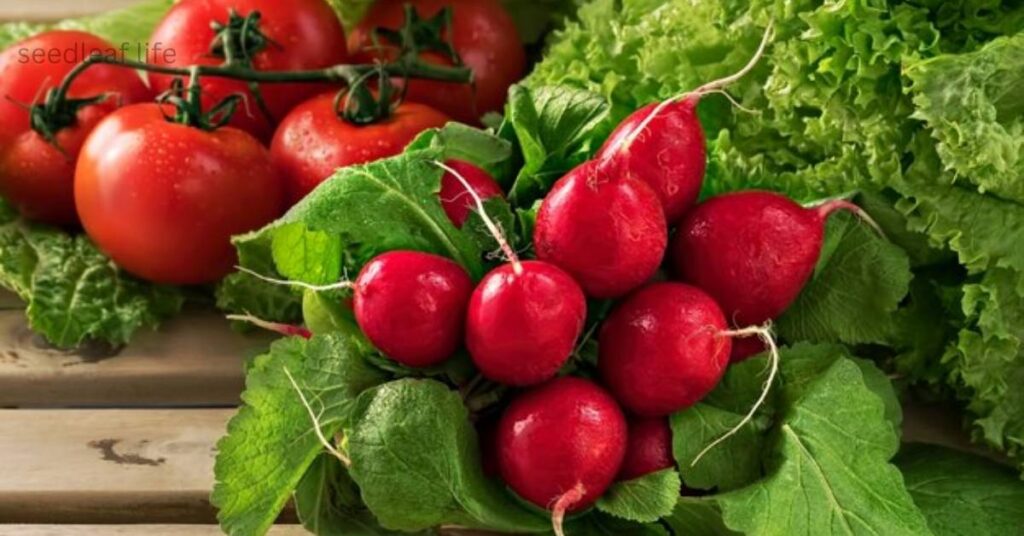
Radishes are quick-growing plants that make excellent companions for tomatoes. They act as a natural trap crop by attracting pests away from tomatoes, keeping your main plants safe. At the same time, radishes mature quickly, giving you an early harvest while tomatoes continue to grow.
Benefits of Radishes with Tomatoes
- Act as a Natural Trap Crop
Radishes attract pests like flea beetles away from tomatoes, keeping the main plants safer.
Provide a Quick Harvest
Radishes mature in just a few weeks, giving gardeners an early crop while waiting for tomatoes to ripen.
Loosen and Aerate the Soil
Their roots break up compacted soil, improving airflow and water absorption for tomato roots.
Require Minimal Space
Radishes grow in small spaces, making them easy to interplant with tomatoes without crowding.
Offer Chemical-Free Protection
By luring pests away, radishes reduce the need for pesticides in a natural way.
Support Tomato Root Health
Loosened soil from radish growth allows tomato roots to spread deeper and stronger.
Encourage Continuous Gardening
Because they grow so quickly, radishes can be planted and harvested multiple times alongside tomatoes.
Improve Garden Efficiency
Their short life cycle ensures no long-term competition with tomato plants.
Add Variety to the Bed
Growing radishes with tomatoes increases crop diversity, creating a more balanced garden ecosystem.
Trusted in Companion Planting
Radishes are a time-tested choice among tomato companion plants, valued for protection and quick rewards.
Quick Reference Chart
| Companion Plant | Main Benefits with Tomatoes | Extra Notes |
Basil | Repels aphids and whiteflies, enhances tomato flavor, attracts pollinators | Also helps reduce fungal issues like Bligh |
Carrots | Loosen soil, improve water and nutrient flow for tomato roots | Grow happily in tomato shade |
| Onions | Repel pests like aphids, slugs, and worms | Take very little space between tomato rows |
| Garlic | Repels spider mites and aphids, reduces fungal problems | Provides an extra flavorful harvest |
| Lettuce | Keeps soil cool and moist, works as a living mulch | Suppresses weeds and thrives in tomato shade |
| Spinach | Thrives under tomato canopy, provides natural ground cove | Quick-growing leafy green alongside tomatoes |
| Beans | Fix nitrogen in soil, boosting tomato growth | Vertical growth saves space, offers a dual harvest |
| Peppers | Share similar soil and water needs, grow well side by side | Attract pollinators and make efficient use of space |
| Celery | Repels pests naturally, adds variety to the bed | Compact size makes it easy to fit near tomatoes |
| Radishes | Act as a trap crop for pests, loosen compact soil | Fast harvest while tomatoes mature |
Conclusion
Companion planting with tomato companion plants is one of the smartest ways to grow healthier and more productive tomatoes. By choosing the right partner plants—like basil, carrots, onions, garlic, lettuce, spinach, beans, peppers, celery, and radishes—you can naturally improve soil health, repel pests, attract pollinators, and enjoy tastier harvests.
Along with companion planting, if you want to know which vegetables are best to grow in September, our September Vegetables Guide will help you plan ahead.
Whether you’re gardening in a small urban space or managing a large farm, these tomato companion plants work globally to boost yield and quality. With the right combinations, your tomato garden can thrive season after season. For a broader overview, you can also check the Old Farmer’s Almanac Companion Planting Guide

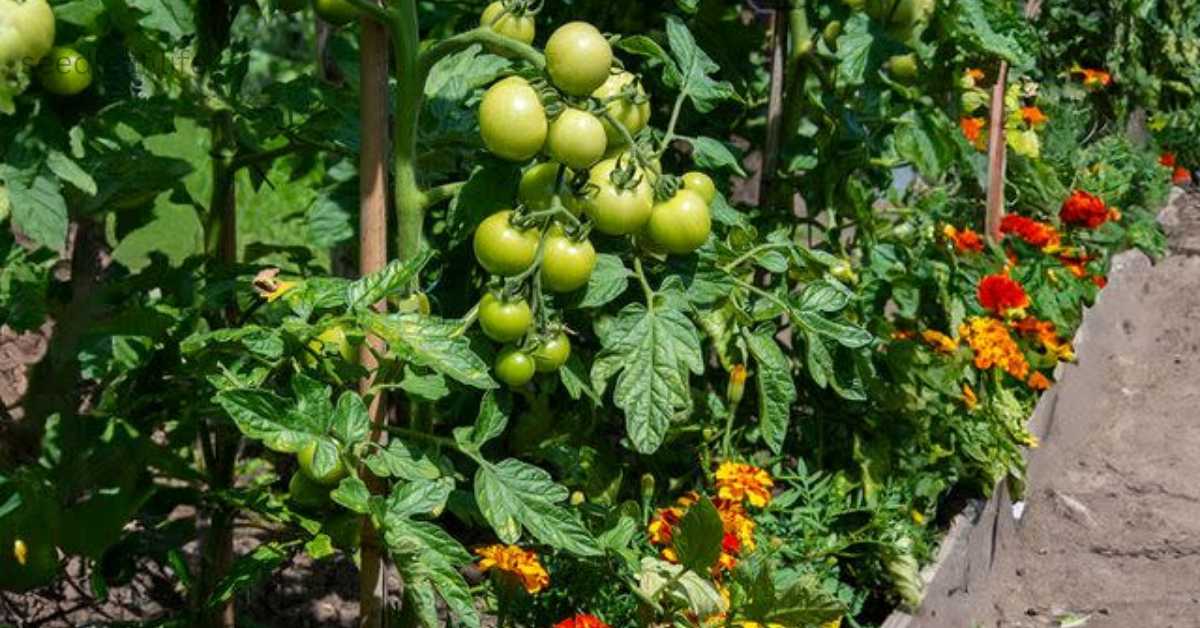
3 responses to “Top 10 Tomato Companion Plants to Boost Harvest Worldwide”
[…] Lettuce is an easy and fast-growing vegetable that thrives well in September. Similarly, if you are planning to grow tomatoes, choosing the right companion plants is equally important. You can read more about it in my article on Tomato Companion Plants […]
[…] can further enhance the growth and yield of your determinate tomatoes. Check out the best tomato companion plants for optimal […]
[…] Basil is another herb that offers multiple benefits. Its strong aroma deters harmful insects while inviting pollinators to the garden. Basil is one of the perfect rose companion plants. Many gardeners also believe it enhances the fragrance of nearby roses. If you are interested in learning more about companion planting, you can also check our guide on Top 10 Tomato Companion Plants […]